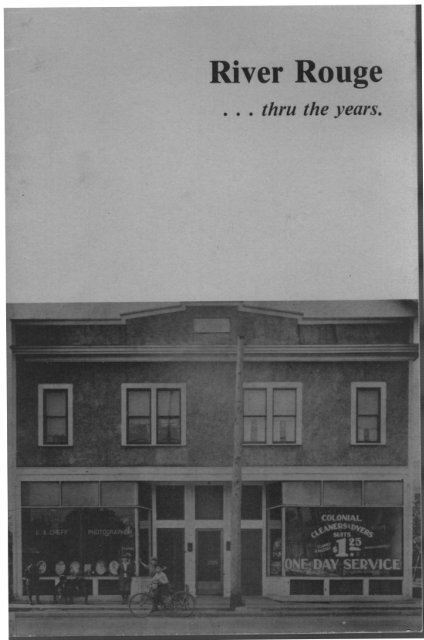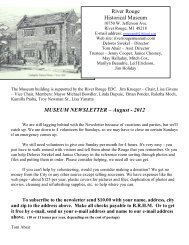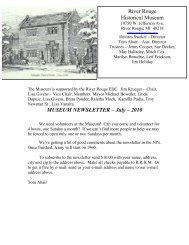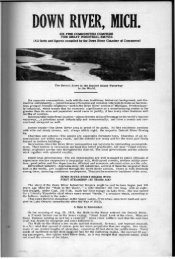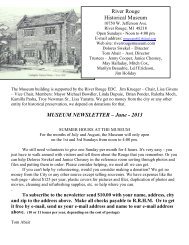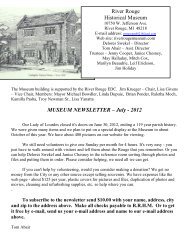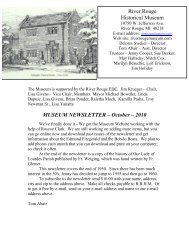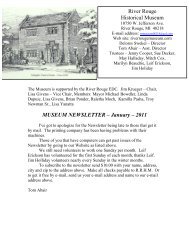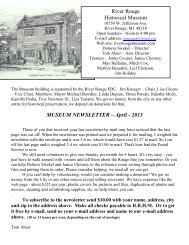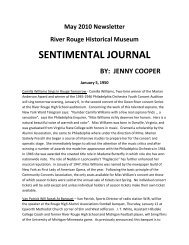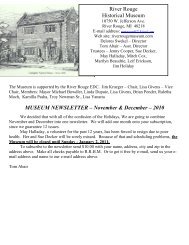CLICK HERE to view a mini history of River Rouge printed by the ...
CLICK HERE to view a mini history of River Rouge printed by the ...
CLICK HERE to view a mini history of River Rouge printed by the ...
- No tags were found...
You also want an ePaper? Increase the reach of your titles
YUMPU automatically turns print PDFs into web optimized ePapers that Google loves.
<strong>River</strong> <strong>Rouge</strong>0 0 .thru <strong>the</strong> years.COLC$I
The His<strong>to</strong>ry <strong>of</strong> <strong>River</strong> <strong>Rouge</strong>Dr. Northrupwas <strong>the</strong> first physician <strong>to</strong> live inRii'er <strong>Rouge</strong>. lie later became <strong>the</strong>second village president, succeedinghenry J'isger.The seeds <strong>of</strong> <strong>River</strong> <strong>Rouge</strong> were sownin <strong>the</strong> late 1700's when French residents <strong>of</strong>Detroit purchased land along <strong>the</strong> <strong>Rouge</strong><strong>River</strong> for a pittance. The Indians didn'tknow <strong>the</strong> value <strong>of</strong> <strong>the</strong> land and sold it forvery small sums <strong>of</strong> money and goods.The Visger family bought a private trac<strong>to</strong>n <strong>the</strong> banks <strong>of</strong> <strong>the</strong> river for "two quarts <strong>of</strong>whiskey and o<strong>the</strong>r valuable considerations."In addition, <strong>the</strong>re were several o<strong>the</strong>r familiesincluded in <strong>the</strong> original land purchases; some<strong>of</strong> <strong>the</strong>se were <strong>the</strong> Riopelle's, Ferguson's,Labadie's, and <strong>the</strong> Godfrey's. These familiesbought strip farms along <strong>the</strong> river. Thesetracts fronted on <strong>the</strong> river and extendedsouth <strong>to</strong> what is now Southfield Road. Even<strong>by</strong> <strong>to</strong>day's standards those were huge pieces<strong>of</strong> land.Pioneering families built <strong>the</strong>ir homesnear <strong>the</strong> river with gardens and fruit treesbehind <strong>the</strong> houses and farm/grazing landbeyond. The farms were built this way <strong>to</strong>protect <strong>the</strong> families that settled <strong>the</strong>re. Allhomes being on <strong>the</strong> river assured every family<strong>of</strong> water, a transportation route, as well asan escape route if Indians attacked. Homeswere only hundreds <strong>of</strong> feet apart <strong>to</strong> allowfamilies <strong>the</strong> ability <strong>to</strong> aide each o<strong>the</strong>r in time<strong>of</strong> need. Early homes were built <strong>of</strong> logs;<strong>the</strong>se later were rebuilt <strong>of</strong> clapboard andpainted white and were surrounded <strong>by</strong> <strong>the</strong>traditional white picket fence.After <strong>the</strong> War <strong>of</strong> 1812, <strong>the</strong> danger <strong>of</strong> Indianattack was reduced and <strong>the</strong> settlers continued<strong>to</strong> move inland in<strong>to</strong> <strong>the</strong> woodlands.As time passed, fa<strong>the</strong>rs divided <strong>the</strong>ir landamong <strong>the</strong>ir sons, who redivided among<strong>the</strong>ir sons, reducing <strong>the</strong> size <strong>of</strong> landholdings. In 1808 <strong>the</strong> census showed 30families at "<strong>River</strong> <strong>Rouge</strong>".
The first bridge spanning <strong>the</strong> <strong>Rouge</strong> <strong>River</strong>.- _•____ -.4_ -.6 IIIn 1817 a wooden <strong>to</strong>ll bridge was constructed over <strong>the</strong> <strong>Rouge</strong><strong>River</strong> at <strong>River</strong> Road (Jefferson Avenue). The bridge had <strong>to</strong> beopened and closed <strong>by</strong> manpower: eight men on each side, who weresent out from <strong>the</strong> sawmills which occupied <strong>the</strong> area. In <strong>the</strong> spring <strong>of</strong><strong>the</strong> year, <strong>the</strong> wooden bridge caused flooding because debris and icegot caught on its moorings. This bridge was replaced in 1890 <strong>by</strong> alarger swing bridge made <strong>of</strong> steel requiring only one man with a key<strong>to</strong> operate it. In 1922 it was replaced <strong>by</strong> a draw bridge which made<strong>the</strong> river navigable for lake freighters en route <strong>to</strong> <strong>the</strong> Ford <strong>Rouge</strong>Plant in Dearborn.<strong>River</strong> <strong>Rouge</strong>, before 1886, was best known as a s<strong>to</strong>pping placefor farmers and travelers on <strong>the</strong>ir way <strong>to</strong> Detroit. As <strong>the</strong> trailsbecame more worn, horse and wagon were used for transportationas well as <strong>the</strong> Detroit <strong>River</strong>. The social life in <strong>the</strong> community wascentered around a picnic area located where <strong>the</strong> municipalbuildings now stand on <strong>the</strong> corner <strong>of</strong> Coolidge Highway (DearbornRoad) and Jefferson (<strong>River</strong> Road); where dances and o<strong>the</strong>r activitieswere held.
Dr. Henri Be/anger• . . a French settler whobecame an expert at treating<strong>the</strong> typhus epidemic tha<strong>to</strong>ccurred eiery spring.On November 30, 1899, <strong>River</strong> <strong>Rouge</strong> organized and became afunctioning political unit. Their first goal was <strong>to</strong> become an independentvillage, ending a 72-year period <strong>of</strong> being considered aspart <strong>of</strong> Ecorse Township. The first president <strong>of</strong> <strong>the</strong> Village wasHenry Visger. The Village Hall was where <strong>the</strong> Burke Buildingstands <strong>to</strong>day on Jefferson at Coolidge Highway. The major problemfacing <strong>the</strong> village at this time was health conditions. The inhabitants<strong>of</strong> <strong>the</strong> village had <strong>to</strong> get water from open wells because<strong>the</strong> high sulphur content <strong>of</strong> drilled well water could not be used.The open wells caused serious illness every spring (typhoid fever).Dr. Belanger, one <strong>of</strong> <strong>the</strong> community's first physicians, became anexpert at detecting and treating typhus.Theophile Be/angerThe i'illages first druggist.Working isit/1 his bro<strong>the</strong>rhenri helped sore <strong>the</strong> lives<strong>of</strong> moor ear/i' citizens. Hispharmaci' it-as located onJefferson.—I
--I MapOfEcorse To wnsh IPb/7610 •----- - j__— Cf.' --.14-L26. sq/ - --p - ---r apo74-". 'tf"iThis map shows <strong>the</strong> early land owners <strong>of</strong> <strong>River</strong><strong>Rouge</strong> as Ecorse Township. <strong>River</strong> <strong>Rouge</strong> became asovereign <strong>to</strong>wnship on November 30, 1899,9e p rr1 irLJiL/ i'1'!•1 11, 1,11101I •i. '3'' 'IjI, 11 a 1 , , I L.II\.11 'p h • c,jI7••570 j,F1:1'I I I i i' ftp' 1 ,l , i, i,; 4,ii ft ' ' I— -- - - -- -- ,-- -- --- --.- -zidl ft' 1 1))(((----
The growth <strong>of</strong> <strong>the</strong> village increased rapidly after <strong>the</strong> turn <strong>of</strong> <strong>the</strong>century. The Talbot Bro<strong>the</strong>rs' Company established a fac<strong>to</strong>ry <strong>to</strong>make cedar blocks and erected a brickyard. The village began <strong>to</strong>grow industrially when <strong>the</strong> Great Lakes Engineering Works built aplant on <strong>the</strong> Detroit <strong>River</strong>.During this same period, <strong>the</strong> village fa<strong>the</strong>rs negotiated a landswap with <strong>the</strong> neighboring village <strong>of</strong> Ecorse. At <strong>the</strong> time it was agood deal. They traded a large section <strong>of</strong> swampland along <strong>the</strong>Detroit <strong>River</strong> for several blocks <strong>of</strong> residential area, extending <strong>the</strong><strong>River</strong> <strong>Rouge</strong> border from Cora <strong>to</strong> Florence. Today, that worthlessswampland is occupied <strong>by</strong> Great Lakes Steel Corp., Nicholson Terminaland Dock Company, and <strong>the</strong> Murray Body Company. (Itshould be noted that <strong>the</strong> village fa<strong>the</strong>rs later redeemed <strong>the</strong>mselves<strong>by</strong> acquiring Zug Island from Ecorse; <strong>the</strong> time <strong>of</strong> this transaction isunknown. This land is now occupied <strong>by</strong> several large and diver -sified corporations, such as <strong>the</strong> Hanna Furnace Company andGreat Lakes Steel.)O<strong>the</strong>r industries came <strong>to</strong> <strong>River</strong> <strong>Rouge</strong> at this time; one <strong>of</strong> <strong>the</strong>sewas Anchor Barrel Works. At one time, many citizens wanted <strong>to</strong>change <strong>the</strong> village name <strong>to</strong> Anchorville after <strong>the</strong> company.The first electric plant was built in 1903. The first fire departmentwas an eight-man volunteer unit headed <strong>by</strong> Chief Marrowt.The first policeman was William Osborn.During <strong>the</strong> First World War, Henry Ford moved his plant <strong>to</strong><strong>the</strong> <strong>Rouge</strong> <strong>River</strong> banks in Dearborn causing a second populationboom in <strong>the</strong> village and leading <strong>to</strong> a vote incorporating it as a city in1921.Workers at (;rea, lakes Engineering Works.4 complete ship being launched at (;rea,Lakes Engineering Works.
H. C. BurkeFounder and 1st president <strong>of</strong> <strong>the</strong><strong>River</strong> <strong>Rouge</strong> Savings Rank.From a small settlement <strong>of</strong> 30 families<strong>to</strong> a city <strong>of</strong> more than 20,000, <strong>River</strong><strong>Rouge</strong> has grown and business flourished,starting with <strong>the</strong> sawmills in <strong>the</strong> early1800's through <strong>the</strong> turbulent early 1930'swhen <strong>the</strong> State <strong>of</strong> Michigan declared abanking holiday. The first bank in <strong>the</strong>State <strong>to</strong> <strong>of</strong>fer deposi<strong>to</strong>rs 100 10 return <strong>of</strong><strong>the</strong>ir savings was <strong>the</strong> <strong>River</strong> <strong>Rouge</strong> SavingsBank, extablished in 1906. The Bank andseveral o<strong>the</strong>r businesses and corporationshave made <strong>River</strong> <strong>Rouge</strong> one <strong>of</strong> <strong>the</strong>strongest communities in sou<strong>the</strong>asternMichigan. In 1972 <strong>the</strong> assessed value <strong>of</strong><strong>River</strong> <strong>Rouge</strong>, including Zug Island, was190 Million Dollars.The citizens <strong>of</strong> <strong>River</strong> <strong>Rouge</strong> should bejustly proud <strong>of</strong> <strong>the</strong>ir city.The original site <strong>of</strong> <strong>the</strong> <strong>River</strong>Ro,ige Savings flank.
E. A. Cheff began pho<strong>to</strong>graphing <strong>River</strong> <strong>Rouge</strong> at <strong>the</strong> age <strong>of</strong>thirteen and continued throughout <strong>the</strong> First World War period. Atthat time pho<strong>to</strong>graphy was in it's pioneering stage <strong>of</strong> development,it was <strong>the</strong> "ba<strong>by</strong>" <strong>of</strong> <strong>the</strong> art world.rThe technique used bears little resemblance <strong>to</strong> pho<strong>to</strong>graphy <strong>to</strong>day.The equipment <strong>the</strong>n used was very heavy and cumbersome and<strong>the</strong> development processes were both painstaking and dangerous. Ihave an above average respect for Mr. E. A. Cheff and his work. Itis men <strong>of</strong> his caliber that made this community what it is <strong>to</strong>day.
NG<strong>River</strong> <strong>Rouge</strong> Savings Bank10474 West Jefferson Ave.1789 Coolidge Hwy.<strong>River</strong> <strong>Rouge</strong>, Michigan 48218


